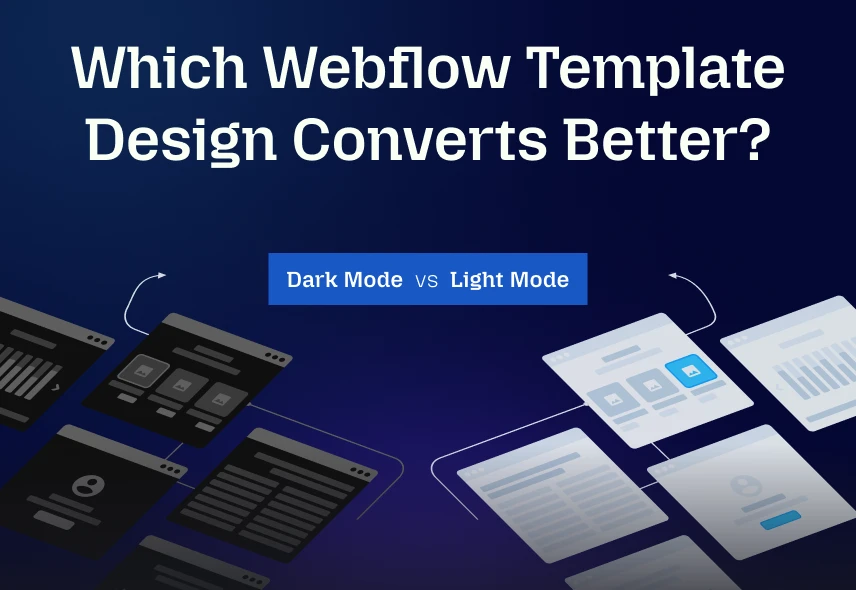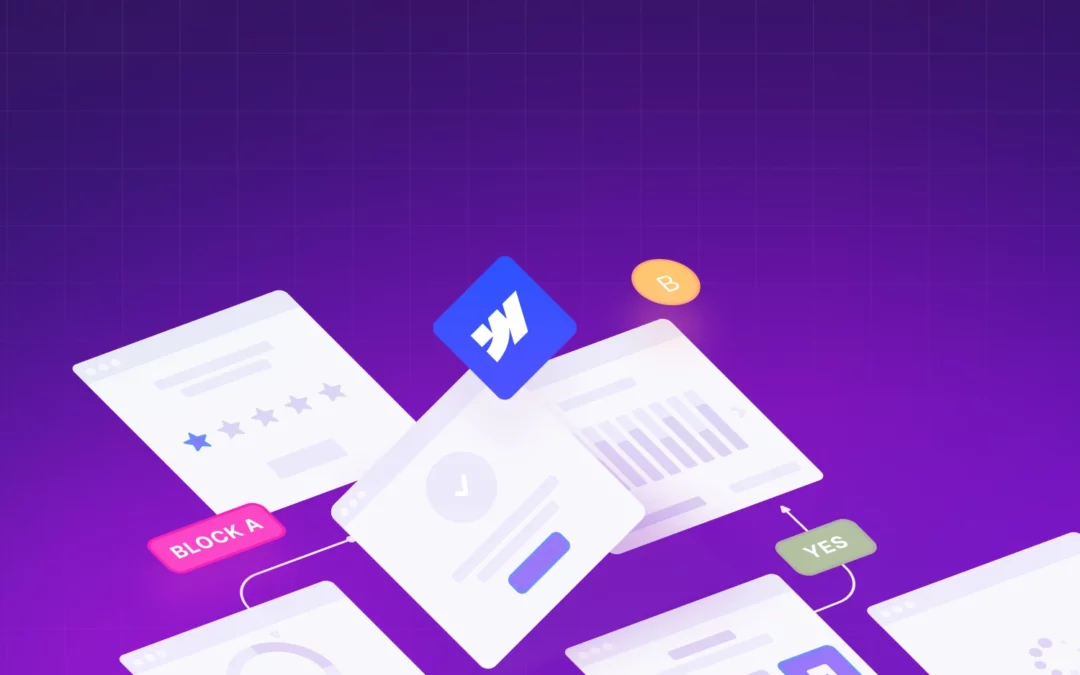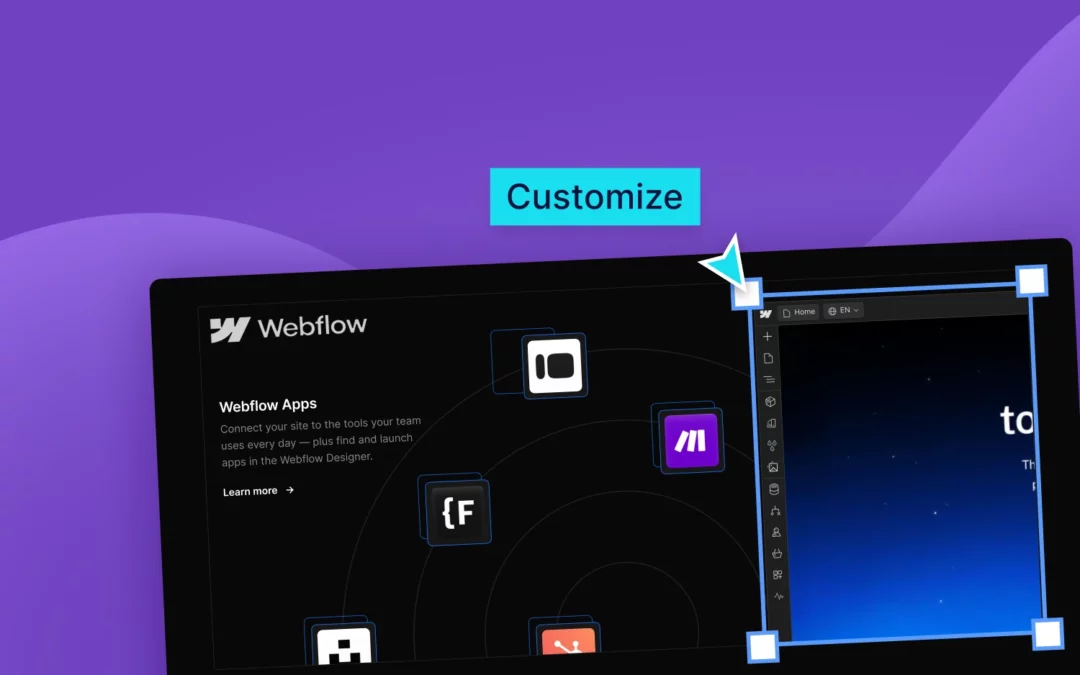Did you know that the colors on your website help people click, sign up, or buy something? We all see websites in dark mode or light mode everywhere. Some people like the modern feel of dark screens. They say it’s comfortable for their eyes. Others prefer the bright and transparent look of a light background. They say it’s easier to read and looks more professional. Choosing between dark mode and light mode for your webflow template design will bring real results. Visitors expect websites to be intuitive and comfortable to use.
A common confusion among designers and marketers is which template actually converts better, dark or light? To answer this, we need to explore how each design affects user behavior and optimize conversion. In this article, I’ll explore the functional differences between dark and light modes. I will also provide practical tips to help you choose the best one for your Webflow project.
Dark Mode in Webflow
Dark mode webflow templates have gained popularity. It combines user-friendly appeal with modern aesthetics. Many users now expect websites to offer a dark mode toggle option:
- Reduced Eye Strain: Dark mode lessens the glare from screens, especially in low-light environments, making browsing more comfortable for extended periods.
- Battery Efficiency: On OLED and AMOLED screens, dark backgrounds use less power, which is a subtle but appreciated perk for mobile users.
- Modern & Premium Feel: A sleek, dark interface can communicate innovation and sophistication. Dark mode is compatible with creative and luxury brands. If your brand identity leans in this direction, dark mode can improve brand value.
- Content Hierarchy: A dark background can make key elements and calls-to-action pop. By using less visible “noise,” your content can direct the user’s eye directly to what you want them to see.
Complexity of Dark Mode:
- Readability in Bright Conditions: The main problem with dark mode is often readability in bright environments. High-contrast light text on a dark background can sometimes be “staggering,” where the text appears blurry. If your visitors are primarily accessing your site from outside, this can be harmful to conversions.
- Color & Branding Challenges: Bright, vibrant brand colors can sometimes be overwhelming in dark mode. You may need to rethink your color palette to ensure your brand identity still shines.
- Not Universally Preferred: A significant number of users still prefer light mode. Dark mode can attract a significant portion of your potential audience.
Light Mode in Webflow
Many Webflow templates are in light mode by default. It’s familiar, easy to scan, and reliable. Let’s take an overview:
- Superior Readability in Daylight: High contrast between dark text and light backgrounds makes content incredibly easy to read. This is especially important for text sites like blogs or news platforms.
- Familiarity & Trust: Light mode helps users feel comfortable and confident. For industries like healthcare, legal, or government sectors, where light mode is highly recommended.
- Content Focus: Light mode can reduce distractions. It helps users focus on the task at hand. This can be important for complex conversion funnels.
- SEO Considerations: Some SEO experts are suggesting that search engines may still recognize light content due to legacy rendering logic.
Complexity of Light Mode:
- Eye Strain in Low Light: The bright glow of Light Mode can be hard on the eyes in low-light environments. This helps users exit quickly.
- Battery Consumption: On OLED/AMOLED screens, light mode consumes more battery than dark mode.
- Less Premium: In some design contexts, a light mode interface may seem less premium than a dark mode.
User Data About Conversion Optimization
There is no single best option between dark and light mode. It depends on the preferences of your visitors across different industries. Data shows that sites offering a dark theme can sometimes keep users on the page longer. This is perfect for those who browse on their phone or in low light. This is because a comfortable viewing experience leads to greater engagement.
However, data also confirms that light mode is still top for easy reading in bright places. So, if your site has a lot of text, light mode might be better. So, the key takeaway from all data on Webflow conversions is this: give your users the choice between dark and light mode. Then test which option works best for your specific website goals.
Dark Mode vs Light Mode for Webflow Conversion
This is a hot debate for Webflow designers and developers. Does dark mode or light mode bring in more business? Let’s look at the differences in a table.
| Feature | Dark Mode Webflow | Light Mode Webflow |
| Eye Strain | Reduced in low light | Can cause strain in dark settings |
| Readability | High with proper contrast | High, most users like it |
| Conversion Rate | Improves engagement, mixed results | Higher for eCommerce, blogs |
| Brand Perception | Modern, innovative | Classic, trustworthy |
| Accessibility | Needs careful contrast management | Easier to achieve |
| Battery Efficiency | Better on OLED screens | Standard |
Webflow Template Design: Best Practices For Conversion
Dark or light mode, the key part is the implementation. Let’s see how to improve conversion optimization for your webflow template design:
1. Offer a Mode Toggle: Allow users to choose their preferred viewing experience. You can use toggles to remember user preferences across sessions, which can increase engagement.
2. Accessibility: Make sure sufficient contrast ratio (at least 4.5:1) for text and interactive elements. This is important for both modes and directly affects conversion.
3. Optimize for Speed: High-converting webflow templates should load quickly. Compressed assets, clean code, and responsive layouts are the most important parts.
4. Strategic Placement of Conversion Elements: Place calls to action, forms, and key content where users expect them.
5. Test & Measurements: Try split testing and analytics to compare conversion rates between dark and light mode designs. Let real user data guide your decisions.
6. Responsive Design: Your Webflow template must be responsive. Many users browse on mobile. Dark mode is preferred on these devices to save battery.
7. Impressive Content & Visuals: Create strong headlines, concise copy, and high-quality visuals that will leave an impression on your audience. Dark or light mode, no template can save a poorly designed website.
Want to see the latest Webflow Dark and Light templates? You can take a look here.
Why Are Different Template Designs Important?
Let’s be honest. Everyone has their preferences. Some love dark mode. They find it easy on the eyes at night, and it looks sleek. Others prefer light mode. They say it’s clearer and more professional in bright rooms. As Webflow builders, we can’t just pick what we like. We need to think about our audience. How these colors affect them matters a lot. It changes how they act on our site. This is why different template designs are important.
Additionally, Webflow has many website templates created by creators like TNCFlow, making your website launch easy and fast. You can start building your website of any type (Agency, Ecommerce, CMS, SaaS, Automotive, Community, marketing, or others) within a few hours. Check out our Webflow templates to get an idea of what kind of unique templates we have prepared for you.

Conclusion
Choosing between dark and light mode for your Webflow template depends on your users and the context of your site. Dark mode offers a modern look and reduces eye strain. Light mode provides better readability and feels trustworthy. Both modes can help increase user engagement and conversions when designed perfectly.
The best approach is to give users the option to switch between dark and light modes. This flexibility lets visitors choose what feels comfortable for them. This improves their experience and increases their ability to take action. If you focus on clear calls to action, good contrast, and fast load times, your webflow template may convert better.





0 Comments